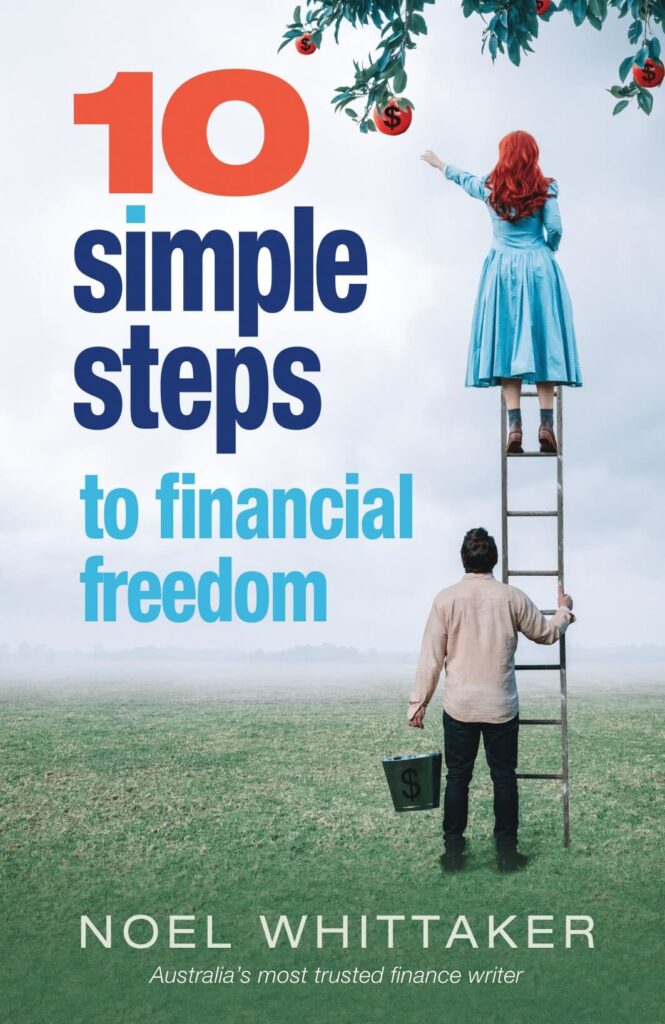Personal financial expert and author Noel Whittaker has written a new book, 10 Simple Steps to Financial Freedom. In this extract, he tells why you need financial goals and how to set them.
•••
Your ability to set and achieve goals will play a major part in your journey to financial freedom. It’s goals that keep us focused and create the energy to keep moving forward. But if you want to get to a specific destination, you need to know where you are starting from.
Imagine that you are lost. “No worries,” you think, “I’ve got a great map on my phone.” There’s just one problem – the GPS can’t pick up your location. And because you have no idea where you are, the map is not much use. It’s the same with goal setting – to successfully plan how to get from point A (here) to point B (the goal), you have to know the location of both points. Therefore, you need to find out exactly where you are now.
Without this vital information, you make it virtually impossible to reach your goals. You need to know what resources you have to work with to achieve your desires.
This means making an inventory of the resources available to you to speed up your journey, as well as any liabilities that may impede your progress.
Read: Why you must understand your risk profile
You’ll need to look at finances, time, energy and other resources, but let’s start with finances. After all, we’re focusing on your journey towards financial freedom. Your list of resources must also include the sources of income at your disposal, because income is the fuel that will turbocharge your journey.
Let me guide you through the steps. First go to my website and find the Resources section. Under ‘Free downloads’, click on Noel’s Action Plan and print yourself a copy. This will be the tool you need to carry out the tasks I have suggested below.
1. List your financial assets. Include bank accounts, superannuation and any property, shares, or similar assets that you may have accumulated at this stage in your life. Don’t include stuff like cars, furniture and sporting equipment, because these are not assets you can use to grow your wealth.
2. List any money you owe. Yes, all your debts. Include the name of the lender, the interest rate, the repayments and when you expect the loan to be paid off. The loan calculators on my website can help you work out how long is left on a loan.
Use this information as your foundation for goal setting. For example, if you have been caught in the credit card trap and have a debt now, a major goal may be to get rid of that debt within one to two years. If you have a car loan, and there are still a few years left to pay it off, you could investigate whether making extra repayments would reduce the term and save interest. But be careful here – some loans are structured so that you pay most of the interest early. If that’s the case, making extra repayments may not save you much.
3. List your income. This is simple if you have one job and no income-earning assets – just write down your usual net take-home pay. If you have any other income such as what you are earning from a second job, or income from investments, put that down too.
Podcast: Noel Whittaker on the economic downturn
Now think about the income you are currently earning, and some ways to increase it. If you are employed now, check you are being paid what you are due, and think about ways to get a promotion.
At the very least, figure out what self-improvement steps you could take to make yourself more valuable to your boss, or to another potential employer. In the meantime, perhaps you could get some overtime, at a higher rate of pay. If you don’t yet have an income, maybe it’s about looking for part-time work.
4. List your expenditure. Seeing where your money goes is often surprising. Few people realise how much their ‘little treats’ add up to: coffee in the morning, a new outfit, craft beers. Equally, people often underestimate the combined cost of regular subscriptions, like an oversize mobile phone plan or a gym subscription you no longer use so much.
Most people think the best place to start is by earning more money, but actually, I recommend you start by trimming your expenditure. Look at your expenses, and think about each item to see if there are ways you can prune it back. I’m not talking about taking all the fun out of life! I’m talking about treating your money with respect for the effort it’s taken you to earn it. Did you know that businesses often exploit their customers’ inertia by increasing fees for long-term customers, or simply not offering them better deals? It’s known as the ‘loyalty tax’. Often, a few phone calls to see if you can get a better deal on regular expenses, like your mobile phone plan, electricity or insurance, will yield impressive savings.
Now that you’re convinced of the value of making some changes, it’s time to turn your ideas into a specific goal, such as increasing your net income by 20 per cent within the next 12 months. It’s worth doing a stocktake of what time, energy and other resources you have to devote to meeting your goal, to make sure you set yourself a realistic goal.
5. Think about your energy too. If you’re bursting with energy in the mornings, but exhausted after a day at school, university or work, you’ll want to look for something you can do in that early part of the day. Or if your week really takes it out of you, perhaps you should focus your efforts on a weekend job, when people will often pay a premium for your time.
6. Other resources. This is where you might list items and/or skills that you could use to earn an income. For example, if you have a car, that opens possibilities for doing deliveries, driving for a rideshare, pooling your car in a car share scheme, or even allowing your car to be used for advertising wraps. If you have a mower and edger, you could do some garden maintenance work. If you like dogs, you could offer to walk your neighbours’ dogs for a fee. If you’re an artist, could you offer custom birthday cards or even investigate the possibilities of selling your work through organisations such as Redbubble? There are so many possibilities out there.
Read: Is life insurance through super worth it?
Examine your lists, and see what they tell you. This is the information you’ll use as the starting point for setting the goals you wish to achieve.
Now you are ready to circle back to the beginning and link your assets and liabilities with your goals. If you have $5000 saved and you want to buy a car for $15,000, your options to get the remaining $10,000 are to wait while you save, or to borrow.
The decision is up to you – you may decide to save another $3000 and borrow $7000. Whatever you choose, you need to adjust your earning and/or spending to ensure that you put enough money away to achieve your savings goal on time.
Remember, it’s the bottom line that counts. To reach financial freedom, you must spend less than you earn. In general, the more income you can earn, the more money you will have available to speed your wealth accumulation process. But that is only true if you remember to keep a part of everything you earn.
Example
If your net income is $30,000 a year and your expenses are $25,000 a year, you have $5000 left over for investment and savings. Congratulations!
You’re keeping just over 16 per cent of your income. You’re already ahead of most people. And if you could increase your net income by 20 per cent to $36,000 a year, and reduce your expenditure by 12 per cent or $3000 to $22,000 a year, you would have $14,000 a year in available savings. That’s right, boosting your income by 20 per cent and reducing your expenditure by 12 per cent increases your savings by a massive 300 per cent. That’s a return worth chasing!
Making a regular assessment of your financial affairs is a fantastic strategy to make sure you continue to focus on your goals, as it pushes you to revisit the strategies you are using now. It will refocus your mind on the financial side of your life too – and the more you do, the more you will learn about money. Remember, the name of the game is to get you money savvy, with realistic goals focused on you becoming financially independent.
Key messages
- You need to know exactly where you are to formulate the steps to achieve a goal: the starting point and the destination are both needed.
- Review your finances regularly and think about ways to increase your assets and income and reduce your liabilities and expenditure.
- Small changes to income and expenses multiply into huge effects on the amount of money you save.
- Check you are paying only for any insurance you actually need — particularly within your superannuation fund.
- Reviewing your net worth regularly is a great way to keep your mind focused on your long-term goals.
Do you need to go back to basics to reassess your financial situation and set goals? Why not share your suggestions in the comments section below?

You can buy 10 Simple Steps to Financial Freedom from Noel Whittaker’s website for $19.95.

